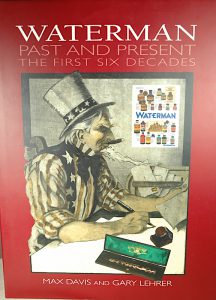Staring at a shelf full of pen books, it struck me that I ought to share with you some of what these great tomes have to offer. As such, I would like to start with a pen-collecting classic.

Here is the cover to “Waterman Past & Present,” a definitive guide to Waterman pens spanning 1883 to 1958. It is a great resource for identifying each model of Waterman pens.
“Waterman Past & Present: The First Six Decades” by authors Max Davis and Gary Lehrer.
If you are just getting into vintage pens and/or Waterman pens, this book is an absolute must. Most professional collectors and dealers I know still use this book as one of their favorite references to identify classic Waterman pens.
The book’s authors are among the most trusted dealers in vintage pens. Max Davis once owned a pen shop in New York City, before moving to Europe to start several very successful websites. According to the book, he contributes most of the European advertising for Waterman and most of the ink displayed in one chapter. The rest of the book was completed by renowned pen expert Gary Lehrer, whose personal Waterman collection was possibly second-to-none. He also created with his wife Myrna one of the most successful vintage pen catalogs online and in print. I had the good fortune to know Gary and Myrna on the pen show circuit, and I was very sorry to learn of Gary’s passing earlier this year. He was an honest, kind and hard working pen man who helped to build pen collecting into the hobby it is today. He also was an excellent pen repairman.
Published in 2008, “Waterman Past & Present” is a 236 page book. Hardbound and coffee-table book size, it sports full-color on almost all of its thick, quality paper pages. After a very brief history about Louis Edson Waterman and his pens from 1883 to 1958, there is very little writing in this book.
Instead, it is a feast of images from common Waterman pens to some of the only known remaining rare models. Most of the pen photos are printed at their actual size, with specific details called out to help differentiate between models that might look similar. Along with the photos of pens are clear, easy to read images of original Waterman catalog pages AND magazine advertisements. Additionally, many of the original bottles of Waterman ink are present.
The only thing missing from this book appears to be Waterman pencils. Some appear in the ads and catalog pages shown, but few are photographed or given much thought.
Nevertheless, this remains a phenomenal resource for identifying Waterman pens, and it is wonderful to be able to see real samples of some rare pens that you and I might never seen in real life.


 Shopping Cart
Shopping Cart




